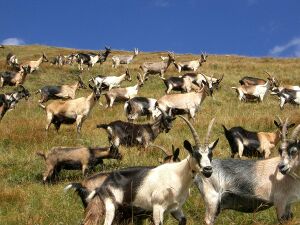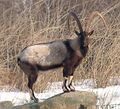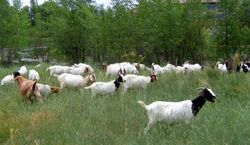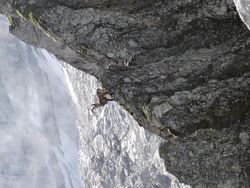Biology:Capra (genus)
| Capra | |
|---|---|

| |
| Capra, St. Leonhard in Passeier, Italy | |
| Scientific classification | |
| Domain: | Eukaryota |
| Kingdom: | Animalia |
| Phylum: | Chordata |
| Class: | Mammalia |
| Order: | Artiodactyla |
| Family: | Bovidae |
| Subfamily: | Caprinae |
| Tribe: | Caprini |
| Genus: | Capra Linnaeus, 1758 |
| Type species | |
| Capra hircus Linnaeus, 1758
| |
| Species | |
|
See text. | |

| |
| Approximate range of the Capra species | |
Capra is a genus of mammals, the goats, comprising ten species, including the markhor and several species known as ibexes. The domestic goat (Capra hircus) is a domesticated species derived from the wild goat (Capra aegagrus). Evidence of goat domestication dates back more than 8,500 years.
Wild goats are animals of mountain habitats. They are very agile and hardy, able to climb on bare rock and survive on sparse vegetation. They can be distinguished from the genus Ovis, which includes sheep, by the presence of scent glands close to the feet, in the groin, and in front of the eyes, and the absence of other facial glands, and by the presence of a beard in some specimens, and of hairless calluses on the knees of the forelegs.[1]
The Rocky Mountain goat is in a separate genus, Oreamnos. Present-day genetic and phenotypic differences between the Capra species are largely related to (1) discontinuity of and impeded migration between Capra populations during glacial periods, and (2) insufficient time in the postglacial period for now-adjoining Capra populations to overcome behavioral mechanisms impeding hybridization in the wild so as to erase these differences.[2]
Taxonomy
All members of the genus Capra are bovids (members of the family Bovidae), and more specifically caprines (subfamily Caprinae). As such they are ruminants, meaning they chew the cud, and have four-chambered stomachs which play a vital role in digesting, regurgitating, and redigesting their food.
The genus has sometimes been taken to include Ovis (sheep) and Ammotragus (Barbary sheep),[3] but these are usually regarded as distinct genera, leaving Capra for ibexes. In this smaller genus, some authors have recognized only two species, the markhor on one side and all other forms included in one species on the other side.[4] Today, nine wild species are usually accepted to which is added the domestic goat:[5]
- West Asian ibex also known as the wild goat (Capra aegagrus)
- Bezoar ibex (Capra aegagrus aegagrus)
- Sindh ibex (Capra aegagrus blythi)
- Domestic goat (Capra hircus; includes feral goat; sometimes considered a subspecies of C. aegagrus)
- Asian ibex also known as the Siberian ibex (Capra sibirica)[6]
- Markhor (Capra falconeri)
- West Caucasian tur (Capra caucasica)
- East Caucasian tur (Capra cylindricornis)
- Alpine ibex (Capra ibex)
- Iberian ibex also known as the Spanish ibex (Capra pyrenaica)[7]
- Nubian ibex (Capra nubiana)
- Walia ibex (Capra walie)
The goats of the genus Capra have complex systematic relationships, which are still not completely resolved. Recent studies based on mitochondrial DNA suggest that the Asian ibex and the Nubian ibex represent distinct species, which are not very closely related to the physically similar Alpine ibex. The Alpine ibex forms a group with the Iberian ibex. The West Caucasian tur appears to be more closely related to the wild goat than to the East Caucasian tur. The markhor is relatively little separated from other forms—previously it had been considered to be a separate branch of the genus.[8]
Almost all wild goat species are allopatric (geographically separated)—the only geographical overlaps are the wild goat (Capra aegagrus) with the East Caucasian tur (Capra cylindricornis), and the markhor (Capra falconeri) with the Asian ibex (Capra sibirica). In both cases, the overlapping species do not usually interbreed in the wild, but in captivity, all Capra species can interbreed, producing fertile offspring.[9]
Species and subspecies
| Image | Scientific name | Common Name | Distribution |
|---|---|---|---|
 |
Capra sibirica | Asian ibex | central and northern Asia, Afghanistan, western and northern China (Primarily Xinjiang), north-western India, south-eastern Kazakhstan, Kyrgyzstan, Tajikistan, eastern Uzbekistan, Mongolia, northern Pakistan, and south-central Russia. |
 |
Capra falconeri | Markhor | Central Asia, Karakoram and the Himalayas |
 |
Capra hircus | Domesticated goat | Domesticated |
 |
Capra aegagrus | Wild goat | Turkey and the Caucasus in the west to Turkmenistan, Afghanistan and Pakistan |
 |
Capra cylindricornis | East Caucasian tur | Greater Caucasus Mountains |
 |
Capra caucasica | West Caucasian tur | Caucasus Mountains range. |
 |
Capra ibex | Alpine ibex | France, Italy, Switzerland, Liechtenstein, Bavaria, Austria and Slovenia |
 |
Capra pyrenaica | Iberian ibex | Iberian Peninsula |
 |
Capra nubiana | Nubian ibex | Egypt, Ethiopia, Eritrea, Israel, Jordan, Lebanon, Oman, Saudi Arabia, Sudan, and Yemen[10] |
 |
Capra walie | Walia ibex | Ethiopia |
Domestication and uses
Along with sheep, goats were among the first domesticated animals. The domestication process started at least 10,000 years ago in what is now northern Iran.[11] Easy human access to goat hair, meat, and milk were the primary motivations. Goat skins were popularly used until the Middle Ages for water and wine bottles when traveling and camping, and in certain regions as parchment for writing.
References
- ↑ Parrini, F. (2009). "Capra ibex (Artiodactyla: Bovidae)". Mammalian Species 830: 1–12. doi:10.1644/830.1.
- ↑ Gavashelishvili, A.; Yarovenko, Y. A.; Babayev, E. A.; Mikeladze, G.; Gurielidze, Z.; Dekanoidze, D.; Kerdikoshvili, N.; Ninua, L. et al. (2018). "Modeling the distribution and abundance of eastern tur (Capra cylindricornis) in the Caucasus". Journal of Mammalogy 99 (4): 885–897. doi:10.1093/jmammal/gyy056.
- ↑ Ansell, W. F. H. 1972. Order Artiodactyla. Part 15. Pp. 1–84, in The mammals of Africa: An identification manual (J. Meester and H. W. Setzer, eds.) [issued 2 May 1972]. Smithsonian Institution Press, Washington, D.C., not continuously paginated. (quoted in Grubb, P. (2005). Wilson, D.E.; Reeder, D.M.. eds. Mammal Species of the World: A Taxonomic and Geographic Reference (3rd ed.). Johns Hopkins University Press. ISBN 978-0-8018-8221-0. OCLC 62265494. http://www.departments.bucknell.edu/biology/resources/msw3/browse.asp?id=14200767.)
- ↑ Haltenorth, T. 1963. Klassifikation der Säugetiere: Artiodactyla I. Handbuch der Zoologie, 8(32):1–167 (quoted in Grubb, P. (2005). Wilson, D.E.; Reeder, D.M.. eds. Mammal Species of the World: A Taxonomic and Geographic Reference (3rd ed.). Johns Hopkins University Press. ISBN 978-0-8018-8221-0. OCLC 62265494. http://www.departments.bucknell.edu/biology/resources/msw3/browse.asp?id=14200767.)
- ↑ Nathalie Pidancier, Steve Jordan, Gordon Luikart, Pierre Taberlet: Evolutionary history of the genus Capra (Mammalia, Artiodactyla): Discordance between mitochondrial DNA and Y-chromosome. Molecular Phylogenetics and Evolution 40 (2006) 739–749 online
- ↑ Sarasa, M. (2023). "Common names of the Asiatic ibex superspecies at a turning point in its taxonomy and management" (in en). Animal Biodiversity and Conservation: 79–86. doi:10.32800/abc.2023.46.0079. ISSN 2014-928X. https://doi.org/10.32800/abc.2023.46.0079.
- ↑ Sarasa, Mathieu; Alasaad, Samer; Pérez, Jesús M. (2012). "Common names of species, the curious case of Capra pyrenaica and the concomitant steps towards the 'wild-to-domestic' transformation of a flagship species and its vernacular names" (in en). Biodiversity and Conservation 21 (1): 1–12. doi:10.1007/s10531-011-0172-3. ISSN 1572-9710. https://doi.org/10.1007/s10531-011-0172-3.
- ↑ Phylogenetic Reconstructions in the Genus Capra (Bovidae, Artiodactyla) Based on the Mitochondrial DNA Analysis. Russian Journal of Genetics, 2007, Vol. 43, No. 2, pp. 181–189. online
- ↑ V. G. Heptner: Mammals of the Sowjetunion Vol. I UNGULATES. Leiden, New York, 1989 ISBN:90-04-08874-1
- ↑ Ross, S.; Elalqamy, H.; Al Said, T.; Saltz, D.. "Capra nubiana". IUCN Red List of Threatened Species 2020: e.T3796A22143385. doi:10.2305/IUCN.UK.2020-2.RLTS.T3796A22143385.en. https://www.iucnredlist.org/species/3796/22143385.
- ↑ Melinda A. Zeder, Brian Hesse: The Initial Domestication of Goats (Capra hircus) in the Zagros Mountains 10,000 Years Ago. Science 24 March 2000: Vol. 287. no. 5461, pp. 2254–2257 online abstract
External links
| Wikimedia Commons has media related to Capra (genus). |
 "Ibex". New International Encyclopedia. 1905.
"Ibex". New International Encyclopedia. 1905.
Wikidata ☰ Q172923 entry
 |





